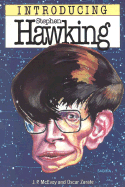 Finished another For Beginners book today. Stephen Hawking for Beginners tells the story of how he started out in the world of theoretical physics, his research into black holes and quantum gravity, how he does research in spite of being afflicted with ALS (amyotrophic lateral sclerosis), plus some funny anecdotes.
Finished another For Beginners book today. Stephen Hawking for Beginners tells the story of how he started out in the world of theoretical physics, his research into black holes and quantum gravity, how he does research in spite of being afflicted with ALS (amyotrophic lateral sclerosis), plus some funny anecdotes.Stephen Hawking first noticed something's wrong in the spring of 1962 when he found it hard to tie his shoelaces. He had contacted ALS, the motor neurone disease, and doctors gave him two years to live. That was his last year in Oxford. It is said that he spent he next few months in deep depression, drinking and listening to Wagner. Near the end of his term at Oxford, he took a bad fall down a staircase (probably due to ALS). He temporarily lost his memory, and couldn't even remember his name. Worried about a possible permanent brain damage, he took the Mensa test for individuals. He scored between 200 and 250.
Another anecdote goes that the class was asked to work on thirteen problems from Electricity and Magnetism by Bleaney & Bleaney. His classmates have been working on the problems for weeks, but only managed to solve one or two. Hawking left it to the last day, spending one morning doing the problems, but managed to finish only the first ten.
The guy is obviously a prodigy, but what makes his achievements even more remarkable is his paralysis. Unlike other scientists, he can't draw out his ideas. He can't perform page-long calculations on equations, writing down intermediate results and referring back to them. Everything has to be done in his head - all mental pictures and mental equations.
At the latter part of the book, the author makes a case as to why Hawking deserves to go to the Royal Academy of Sciences in Stockholm and pick up his Nobel Prize. It's not going to be easy because the award calls for theoretical discoveries to be verified by experiment. And for cosmologists like Hawking, who deal with theories involving the whole Universe, this might take forever.
No comments:
Post a Comment